Information injection-pump assembly
BOSCH
9 400 618 473
9400618473
ZEXEL
106873-7180
1068737180
MITSUBISHI
ME161702
me161702
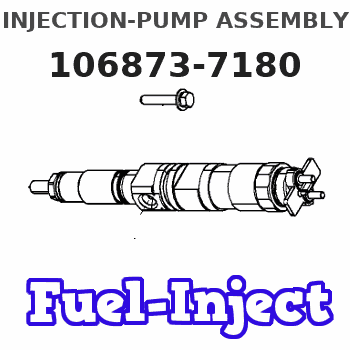
Rating:
Service parts 106873-7180 INJECTION-PUMP ASSEMBLY:
1.
_
7.
COUPLING PLATE
8.
_
9.
_
11.
Nozzle and Holder
12.
Open Pre:MPa(Kqf/cm2)
15.7(160)/24.5(250)
15.
NOZZLE SET
Include in #1:
106873-7180
as INJECTION-PUMP ASSEMBLY
Cross reference number
BOSCH
9 400 618 473
9400618473
ZEXEL
106873-7180
1068737180
MITSUBISHI
ME161702
me161702
Zexel num
Bosch num
Firm num
Name
106873-7180
9 400 618 473
ME161702 MITSUBISHI
INJECTION-PUMP ASSEMBLY
8M20 K
8M20 K
Calibration Data:
Adjustment conditions
Test oil
1404 Test oil ISO4113 or {SAEJ967d}
1404 Test oil ISO4113 or {SAEJ967d}
Test oil temperature
degC
40
40
45
Nozzle and nozzle holder
105780-8250
Bosch type code
1 688 901 101
Nozzle
105780-0120
Bosch type code
1 688 901 990
Nozzle holder
105780-2190
Opening pressure
MPa
20.7
Opening pressure
kgf/cm2
211
Injection pipe
Outer diameter - inner diameter - length (mm) mm 8-3-600
Outer diameter - inner diameter - length (mm) mm 8-3-600
Overflow valve
131425-0220
Overflow valve opening pressure
kPa
157
123
191
Overflow valve opening pressure
kgf/cm2
1.6
1.25
1.95
Tester oil delivery pressure
kPa
255
255
255
Tester oil delivery pressure
kgf/cm2
2.6
2.6
2.6
Direction of rotation (viewed from drive side)
Right R
Right R
Injection timing adjustment
Direction of rotation (viewed from drive side)
Right R
Right R
Injection order
1-2-7-3-
4-5-6-8
Pre-stroke
mm
3.9
3.85
3.95
Beginning of injection position
Governor side NO.1
Governor side NO.1
Difference between angles 1
Cyl.1-2 deg. 45 44.5 45.5
Cyl.1-2 deg. 45 44.5 45.5
Difference between angles 2
Cal 1-7 deg. 90 89.5 90.5
Cal 1-7 deg. 90 89.5 90.5
Difference between angles 3
Cal 1-3 deg. 135 134.5 135.5
Cal 1-3 deg. 135 134.5 135.5
Difference between angles 4
Cal 1-4 deg. 180 179.5 180.5
Cal 1-4 deg. 180 179.5 180.5
Difference between angles 5
Cal 1-5 deg. 225 224.5 225.5
Cal 1-5 deg. 225 224.5 225.5
Difference between angles 6
Cal 1-6 deg. 270 269.5 270.5
Cal 1-6 deg. 270 269.5 270.5
Difference between angles 7
Cal 1-8 deg. 315 314.5 315.5
Cal 1-8 deg. 315 314.5 315.5
Injection quantity adjustment
Adjusting point
-
Rack position
12.5
Pump speed
r/min
650
650
650
Each cylinder's injection qty
mm3/st.
138
133.9
142.1
Basic
*
Fixing the rack
*
Standard for adjustment of the maximum variation between cylinders
*
Injection quantity adjustment_02
Adjusting point
Z
Rack position
8.5+-0.5
Pump speed
r/min
380
380
380
Each cylinder's injection qty
mm3/st.
23
19.5
26.5
Fixing the rack
*
Standard for adjustment of the maximum variation between cylinders
*
Injection quantity adjustment_03
Adjusting point
A
Rack position
R1(12.5)
Pump speed
r/min
650
650
650
Average injection quantity
mm3/st.
138
137
139
Basic
*
Fixing the lever
*
Injection quantity adjustment_04
Adjusting point
B
Rack position
R1+0.9
Pump speed
r/min
1100
1100
1100
Average injection quantity
mm3/st.
132
128
136
Fixing the lever
*
Test data Ex:
Governor adjustment
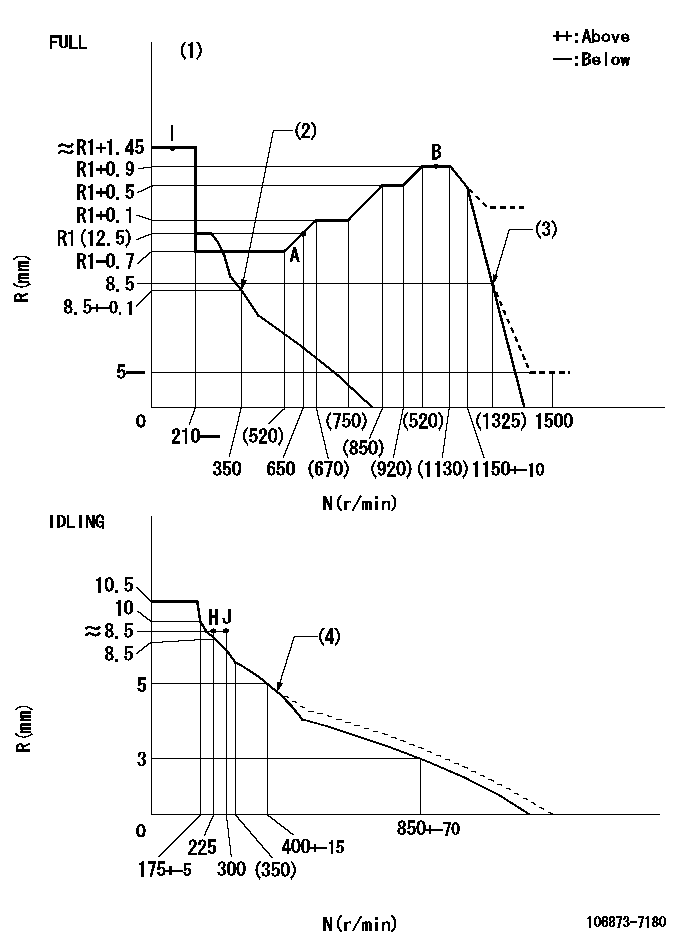
N:Pump speed
R:Rack position (mm)
(1)Torque cam stamping: T1
(2)Air cylinder OFF
(3)Air cylinder ON
(4)Damper spring setting: DL
----------
T1=AB95 DL=6.4-0.2mm
----------
----------
T1=AB95 DL=6.4-0.2mm
----------
Timer adjustment
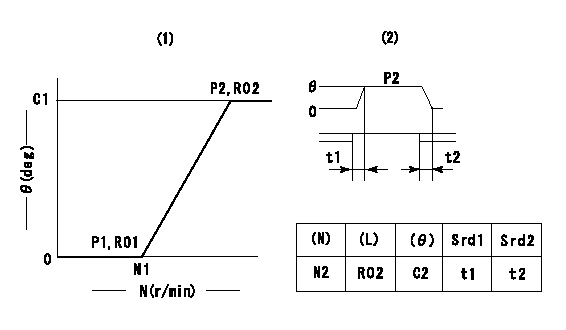
(1)Adjusting range
(2)Step response time
(N): Speed of the pump
(L): Load
(theta) Advance angle
(Srd1) Step response time 1
(Srd2) Step response time 2
1. Adjusting conditions for the variable timer
(1)Adjust the clearance between the pickup and the protrusion to L.
----------
L=1-0.2mm N2=800r/min C2=(10)deg t1=2.5--sec. t2=2.5--sec.
----------
N1=750++r/min P1=0kPa(0kgf/cm2) P2=392kPa(4kgf/cm2) C1=10+-0.3deg R01=0/4load R02=4/4load
----------
L=1-0.2mm N2=800r/min C2=(10)deg t1=2.5--sec. t2=2.5--sec.
----------
N1=750++r/min P1=0kPa(0kgf/cm2) P2=392kPa(4kgf/cm2) C1=10+-0.3deg R01=0/4load R02=4/4load
Speed control lever angle
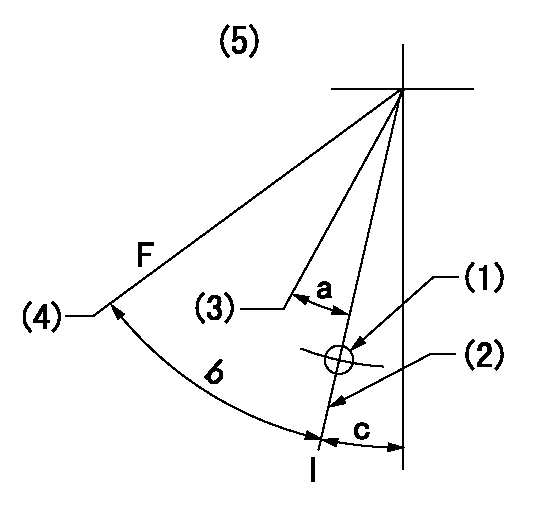
F:Full speed
I:Idle
(1)Use the hole at R = aa
(2)Stopper bolt set position 'H'
(3)When air cylinder OFF
(4)When air cylinder ON.
(5)Viewed from feed pump side.
----------
aa=37.5mm
----------
a=(6deg) b=(34deg)+-3deg c=30deg+-5deg
----------
aa=37.5mm
----------
a=(6deg) b=(34deg)+-3deg c=30deg+-5deg
Stop lever angle
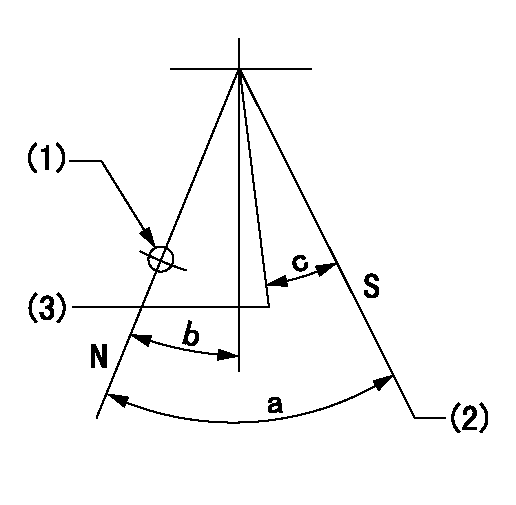
N:Pump normal
S:Stop the pump.
(1)Use the hole at R = aa
(2)At pump speed bb and rack position cc, set the stopper bolt. (Confirm non-injection.)
(3)Normal engine position (Rack position corresponding to dd)
----------
aa=31.5mm bb=1100r/min cc=3.5+-0.3mm dd=18mm
----------
a=41deg+-5deg b=13deg+-5deg c=(31deg)
----------
aa=31.5mm bb=1100r/min cc=3.5+-0.3mm dd=18mm
----------
a=41deg+-5deg b=13deg+-5deg c=(31deg)
0000001501 MICRO SWITCH
Adjustment of the micro-switch
Adjust the bolt to obtain the following lever position when the micro-switch is ON.
(1)Speed N1
(2)Rack position Ra
----------
N1=325r/min Ra=8.5+-0.1mm
----------
----------
N1=325r/min Ra=8.5+-0.1mm
----------
0000001601 RACK SENSOR
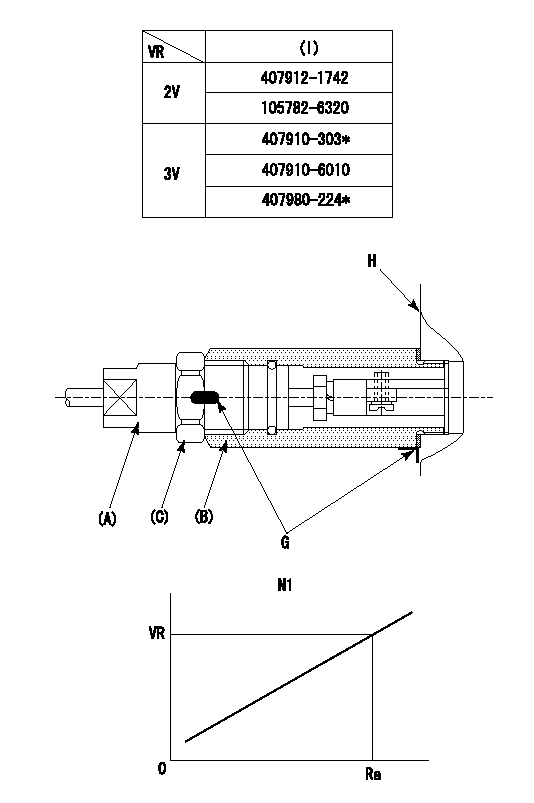
(VR) measurement voltage
(I) Part number of the control unit
(G) Apply red paint.
(H): End surface of the pump
1. Rack sensor adjustment (-0620)
(1)Fix the speed control lever at the full position
(2)Set the speed to N1 r/min.
(If the boost compensator is provided, apply boost pressure.)
(3)Adjust the bobbin (A) so that the rack sensor's output voltage is VR+-0.01.
(4)At that time, rack position must be Ra.
(5)Apply G at two places.
Connecting part between the joint (B) and the nut (F)
Connecting part between the joint (B) and the end surface of the pump (H)
----------
N1=1100r/min Ra=R1(12.5)+0.9mm
----------
----------
N1=1100r/min Ra=R1(12.5)+0.9mm
----------
0000001701 AIR CYLINDER

(A) stopper bolt
(B) stopper bolt
(C) stopper bolt
(a) lever
(b) air cylinder
(c) speed lever
(d) Nut
(e) nut
1. Stopper bolt A adjusting method
(1)When air cylinder pressure is P1, set the gap between the lever (a) and the air cylinder (b) to L1.
(2)Apply P2 to the air cylinder.
(3)Confirm that the speed lever (c) operates between idling and full speed positions.
(4)Fix the stopper bolt A using nut d.
2. Stopper bolt <B> adjustment method.
(1)At air cylinder pressure P1, pump speed N1 and rack position is Ra, adjust stopper bolt (B) so that the speed lever (c) is in the stop position.
(2)Move the lever a several times and then fix the stopper bolt B using the nut e.
(3)Nut d tightening torque: T1
(4)Nut e tightening torque: T2
----------
L1=(1)mm P1=0kPa(0kgf/cm2) P2=392+98kPa(4+1kgf/cm2) N1=350r/min Ra=8.5+0.1mm T1=4.9~7N-m(0.5~0.7kgf-m) T2=4.9~7N-m(0.5~0.7kgf-m)
----------
----------
L1=(1)mm P1=0kPa(0kgf/cm2) P2=392+98kPa(4+1kgf/cm2) N1=350r/min Ra=8.5+0.1mm T1=4.9~7N-m(0.5~0.7kgf-m) T2=4.9~7N-m(0.5~0.7kgf-m)
----------
Timing setting

(1)Pump vertical direction
(2)Coupling's key groove position at No 1 cylinder's beginning of injection
(3)B.T.D.C.: aa
(4)-
----------
aa=6deg
----------
a=(45deg)
----------
aa=6deg
----------
a=(45deg)
Information:
Priming the Fuel System
Fuel leaked or spilled on to hot surfaces or electrical components can cause a fire. Clean up fuel spills immediately.
Prime the fuel system to fill dry fuel filters and purge trapped air. The fuel system requires priming after:* being run dry* storage* fuel filter cleaning/replacement If the engine does not have a fuel priming pump, go to step 4.1. Unlock and operate the priming pump until a resistance is felt. A considerable number of pump strokes may be required.2. Push in and hand-tighten the plunger.3. Crank the engine. If the engine starts, but runs rough, continue running the engine at low idle until the engine runs smoothly.
Do not crank the engine for more than 30 seconds. If the engine does not start, allow the starter motor to cool for two minutes before cranking again.
If the engine will not start, or once started, continues to misfire or smoke, further priming is necessary. Repeat steps 1 through 3. If operating problems persist after repeating steps 1 through 3, further priming is necessary.4. Open the vent valve (if equipped) on the fuel injection pump housing.
DO NOT remove the plug in the fuel filter base (for the fuel pressure sending unit [if equipped]) to purge air from the fuel system. Periodic removal of the plug will result in increased wear of the threads in the fuel filter base and lead to fuel leakage.
5. Operate the priming pump until the flow of fuel from the vent valve is continuous and free of air bubbles. If the engine does not have a fuel priming pump, crank the engine until the fuel flows free of air bubbles. Do not crank the engine for more than 30 seconds. Allow the starter to cool for two minutes before cranking again.6. Close the vent valve. Push in and hand-tighten the plunger.7. Crank the engine. If the engine starts, but runs rough, continue running the engine at low idle until the engine runs smoothly. If the engine will not start, or once started, continues to misfire or smoke, further priming is necessary.8. Loosen the fuel line nuts, one at a time, at the valve cover base.
A fuel injection nozzle will be damaged if the top of the nozzle turns in the body. The engine will be damaged if a defective fuel injection nozzle is used because the fuel spray pattern that comes out of the nozzle will be incorrect. Fuel injection nozzles can be permanently damaged by twisting if only one wrench is used to loosen or tighten the fuel line nuts. Do NOT let the tops of the fuel nozzles turn when the fuel lines are loosened. Use one wrench to hold the nozzle and another to loosen the fuel line nut.
Operate the priming pump plunger until the flow of fuel from the fuel line is continuous and free of air bubbles. Push the plunger in and tighten by hand. If the engine does not have a fuel priming pump, crank the engine.Tighten each fuel
Fuel leaked or spilled on to hot surfaces or electrical components can cause a fire. Clean up fuel spills immediately.
Prime the fuel system to fill dry fuel filters and purge trapped air. The fuel system requires priming after:* being run dry* storage* fuel filter cleaning/replacement If the engine does not have a fuel priming pump, go to step 4.1. Unlock and operate the priming pump until a resistance is felt. A considerable number of pump strokes may be required.2. Push in and hand-tighten the plunger.3. Crank the engine. If the engine starts, but runs rough, continue running the engine at low idle until the engine runs smoothly.
Do not crank the engine for more than 30 seconds. If the engine does not start, allow the starter motor to cool for two minutes before cranking again.
If the engine will not start, or once started, continues to misfire or smoke, further priming is necessary. Repeat steps 1 through 3. If operating problems persist after repeating steps 1 through 3, further priming is necessary.4. Open the vent valve (if equipped) on the fuel injection pump housing.
DO NOT remove the plug in the fuel filter base (for the fuel pressure sending unit [if equipped]) to purge air from the fuel system. Periodic removal of the plug will result in increased wear of the threads in the fuel filter base and lead to fuel leakage.
5. Operate the priming pump until the flow of fuel from the vent valve is continuous and free of air bubbles. If the engine does not have a fuel priming pump, crank the engine until the fuel flows free of air bubbles. Do not crank the engine for more than 30 seconds. Allow the starter to cool for two minutes before cranking again.6. Close the vent valve. Push in and hand-tighten the plunger.7. Crank the engine. If the engine starts, but runs rough, continue running the engine at low idle until the engine runs smoothly. If the engine will not start, or once started, continues to misfire or smoke, further priming is necessary.8. Loosen the fuel line nuts, one at a time, at the valve cover base.
A fuel injection nozzle will be damaged if the top of the nozzle turns in the body. The engine will be damaged if a defective fuel injection nozzle is used because the fuel spray pattern that comes out of the nozzle will be incorrect. Fuel injection nozzles can be permanently damaged by twisting if only one wrench is used to loosen or tighten the fuel line nuts. Do NOT let the tops of the fuel nozzles turn when the fuel lines are loosened. Use one wrench to hold the nozzle and another to loosen the fuel line nut.
Operate the priming pump plunger until the flow of fuel from the fuel line is continuous and free of air bubbles. Push the plunger in and tighten by hand. If the engine does not have a fuel priming pump, crank the engine.Tighten each fuel
Have questions with 106873-7180?
Group cross 106873-7180 ZEXEL
Mitsubishi
Mitsubishi
Mitsubishi
Mitsubishi
Mitsubishi
Mitsubishi
Mitsubishi
106873-7180
9 400 618 473
ME161702
INJECTION-PUMP ASSEMBLY
8M20
8M20